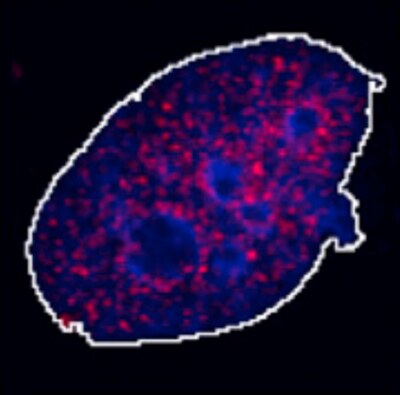How cells repair toxic DNA damage

Researchers at the University of Oxford and Nanyang Technological University, Singapore (NTU Singapore) say they have uncovered the mechanism by which cells identify and repair a highly toxic form of DNA damage that causes cancer, neurodegeneration and premature aging.
The team’s findings reveal how harmful DNA lesions called DNA-protein crosslinks (DPCs) are recognised and broken down by SPRTN, a key repair enzyme. Their work has been published in the journal Nucleic Acids Research and has important implications for improving cancer therapy and healthy aging.
Every time a cell divides into two, it must accurately create a copy of all its DNA — a process that involves the tight coordination of sophisticated molecular machinery. DPCs, which can be induced by chemotherapy drugs, environmental agents like formaldehyde, UV exposure and normal cellular metabolism, are bulky lesions in which unwanted proteins attach to DNA, blocking the process of copying the cell’s DNA. If left unrepaired, DPCs can cause neurodegeneration, premature aging and cancer; therefore, understanding how these lesions are repaired is crucial for protecting genome integrity and preventing these conditions.
SPRTN is a critical enzyme that protects cells against DPC lesions. It travels along the DNA and degrades the proteins in the lesions, which clears the blockage and enables the DNA copying process to proceed. It was previously unknown how SPRTN specifically breaks down DPC lesions without damaging functional proteins in the cell.

The research team has now discovered a specialised region within SPRTN which drives its activity against DPCs. The region detects chains of ubiquitin — tiny tags that attach to other proteins to modify their function — which DPC lesions have in abundance. Recognition of these tags directly guides SPRTN to the DPC lesions, triggering a rapid increase in its activity to break down the harmful protein attachments.
“In the absence of ubiquitin chains on DPCs, SPRTN is slow and inefficient, taking hours to clear the DNA lesions,” said study leader Kristijan Ramadan, Toh Kian Chui Distinguished Professor in Cancer and Stem Cell Biology at NTU Singapore and Honorary Senior Researcher at the University of Oxford.
“But when the ubiquitin chains are present, SPRTN’s ability to specifically target DPCs and break them down is enhanced 67-fold, enabling rapid removal of DPCs, which is critical due to its role in the rapid repair of DNA.”
Importantly, the team showed that longer chains significantly accelerated the repair process compared to when only one or two ubiquitin tags were attached to the DNA lesion. This allows SPRTN to act quickly on DPCs while sparing other proteins that lack these tags.
The discovery of SPRTN’s recognition mechanism provides essential insights into our cells’ natural defences and how defects in DPC repair can drive disease. For example, mutations in the SPRTN gene are known to cause Ruijs-Aalfs syndrome, a rare condition characterised by chromosomal instability, premature aging and a high risk of early-onset liver cancer.
“Our body’s ability to repair DNA damage caused by DPCs has long been a mystery,” said first author Dr Wei Song, a postdoctoral researcher at the University of Oxford. “But now that we know how the repair mechanism works, we’ve laid the groundwork for developing potential ways to strengthen the body’s defences against age-related diseases, as well as reduce the side effects of cancer therapies that damage DNA.”
Commenting as an independent expert, Dr Jens Samol from Singapore’s Tan Tock Seng Hospital said the study is significant as it identified that ubiquitin chains act as the main signal for SPRTN’s rapid activation and are very likely the main signal for SPRTN to specifically target and break down DPCs heavily tagged with ubiquitin.
“These findings further the understanding of SPRTN’s ability to specifically degrade DPCs and prevent normal cells from becoming cancerous,” Samol said. “Moreover, some cancer patients are resistant to chemotherapy that kills tumour cells by inducing DPCs in them.
“The involvement of ubiquitin shown by the study opens the possibility of investigating whether anti-ubiquitin antibodies or ubiquitin-proteasome inhibitors, such as bortezomib, could be potentially used as therapeutic options for overcoming cancer patients’ resistance to chemotherapy drugs. This concept could be tested in animal models like mice.”
Future studies by the researchers, including ongoing work in zebrafish, mouse models and human tissues, aim to validate their findings and further explore the potential of strengthening DPC repair mechanisms. This research could further revolutionise our understanding of the processes of aging and cancer, as well as identify potential therapeutic interventions.
Mini lung organoids could help test new treatments
Scientists have developed a simple method for automated the manufacturing of lung organoids...
Clogged 'drains' in the brain an early sign of Alzheimer’s
'Drains' in the brain, responsible for clearing toxic waste in the organ, tend to get...
World's oldest known RNA extracted from woolly mammoth
The RNA sequences are understood to be the oldest ever recovered, coming from mammoth tissue...





